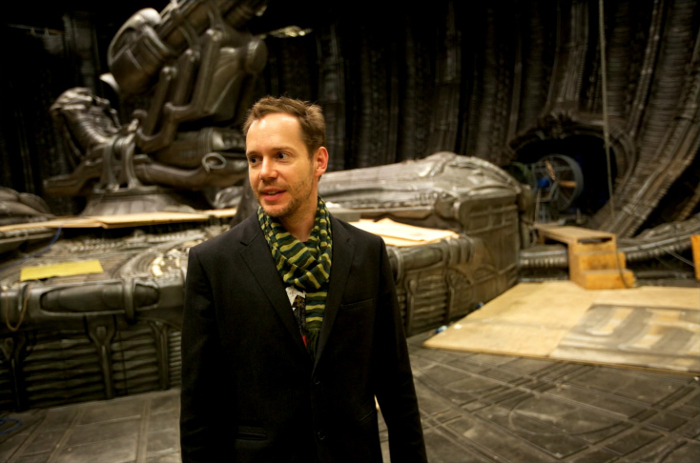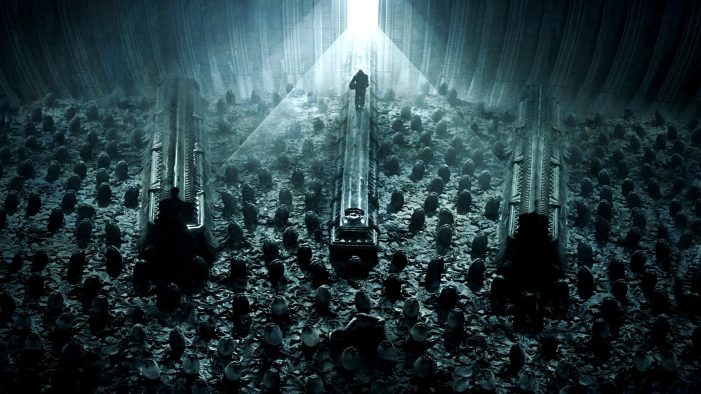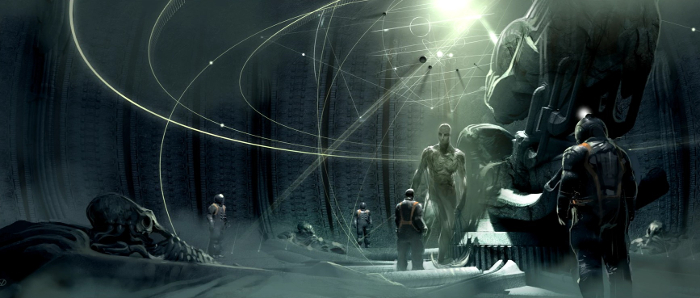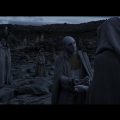Engineering Prometheus – From Jon Spaihts to Damon Lindelof
Posted by Corporal Hicks on May 6, 2016 (Updated: 22-Aug-2023)
Prometheus was a film that had a lot of Alien fans unsure of what they would be getting when they walked into that cinema. It started life as an Alien prequel, then it became an original science-fiction known as Prometheus. It was not clear if Prometheus would be related to Alien at all.
Of course, it turns out it was. But it was an unclear time and an interesting film development. Whilst we wait for Alien: Covenant (another film that started its life as one thing and has seemingly changed into another), I decided to take a look at how its predecessor changed over time and how it went from one writer to another.
The possibility of an Alien prequel was commented on as early as the late 1970s. The official Alien magazine published in December 1979 reported that one of the possible avenues that were being explored for the next Alien film would be a prequel: “A prequel, rather than a sequel, telling the tale of the Space Jockey and ending where Alien begins, with the arrival of the Nostromo crew.” Ultimately this take on a new Alien film would not emerge as the sequels veered away from the mysterious extra-terrestrial victim.
The notion of a film exploring the untold history of Alien in more depth is something that has existed in Ridley Scott’s brain since he finished work on Alien. Talking to Omni’s Screen Flights/Screen Fantasies back in 1984, he commented on his desire to delve into the history of the Alien:
“It certainly should explain what the Alien is and where it comes from. That will be tough because it will require dealing with other planets, worlds, civilisations. Because obviously the Alien did come from some sort of civilisation. The Alien was presented, really, as one of the last survivors of Mars – a planet named after the god of war. The Alien may be one of the last descendants of some long-lost self-destructed group of beings.”

Ridley Scott on the Space Jockey set on Alien. H.R Giger can be seen working on the creature in the background.
Over the intervening years Ridley Scott would occasionally talk about his desire to return to the Alien franchise to specifically explore the Space Jockey. During one such occasion on the commentary that Ridley Scott recorded for the 20th anniversary DVD release of Alien for the Alien Legacy box-set, Ridley Scott mused about his ideas behind the Space Jockey and the Derelict.
“I always wanted to go back and make an Alien 5 or 6 where we find out where they came from and go and answer the question “who are they?” Mars is too close, they can’t be Gods of War. But the theory was – in my head – that this was an aircraft carrier, a battle wagon of a civilization and the eggs were a cargo that was essentially weapons; like a large form of bacterial/biomechaniod warfare.”
Following the tepid release of Alien Resurrection in 1997, movement on a new Alien film was virtually non-existent. Occasionally Ridley Scott, James Cameron or Sigourney Weaver would give the possibility a sentence or two in interviews but it wasn’t until over a decade later in 2009 that a new Alien film was looking like a reality.
Having been impressed by his work on two science fiction scripts – Passengers and Shadow 19 – Scott Free Productions invited relative new comer Jon Spaihts to a meeting with Scott Free’s president, Michael Costigan, to discuss potential ideas for Spaihts and the company to work together on.
Late in the meeting, Costigan brought up the topic of Alien, specifically an Alien prequel. It was a universe that Ridley Scott wanted to return to but they had been unable to crack the story. Costigan wanted to know if Spaihts had any ideas about it.
Speaking of the meeting, Spaihts remarked that “it was interesting because it was a question I had never asked myself or been asked before, and certainly nothing I had prepared for the meeting. But, I found that, when the question was asked, I had opinions that were, in fact, pretty strong opinions, so I just started riffing.”
Spaihts spoke for 30 or 40 minutes, talking about the mysteries left unexplored after Alien, mysteries that would revolve around the Space Jockey, something Scott had wanted to explore himself:
“I said well you have to go back to the ship wreck where it all sprang. You’d have to look at the dead giant, the dead Space Jockey, the dead giant in the chair with the Elephantine proboscis ribcage.”
At the end of the meeting, Costigan asked Spaihts to write down his story idea (which would be known as Alien 01: The Master Narrative) so that they could be passed onto Ridley Scott, who was finishing post-production on Robin Hood at the time. In less than two weeks that story concept had worked its way from a document in the hands of Ridley Scott all the way to the top of 20th Century Fox and into the start of a film production.

Alien 01: The Master Narrative
Ridley Scott’s brother, the late Tony Scott, was the one to reveal to the world that they were working on an Alien prequel. In May of 2009, whilst talking to Collider about Taking of Pelham 123, Tony Scott announced that the Alien prequel was going to be directed by Carl Rinsch, one of the advertisement directors at Scott Free.
Ridley Scott was eventually announced as being attached to direct. Early reports made it sound as if 20th Century Fox were not confident in moving forward with the prequel without Scott in the director’s chair but it became quite clear that it was Ridley Scott’s own excitement towards the project that led to him taking over as director.
Spaihts wrote the first draft in three and a half weeks, something he said to be “a personal record.” Following that Spaihts wrote another four significant drafts (with many “interim submissions”) over the next year or so. By April 23rd 2010 Spaihts was on his fourth draft; most likely the draft available online under the title Alien: Engineers.
When that script was leaked online, Alien vs Predator Galaxy spoke to Jon Spaihts who confirmed that the script was one of the later but not the last draft he did. The subsequent draft would lose Weyland’s Wheel and the underwater excavation from the start of the script. When Damon Lindelof came on board in mid-2010 the current draft was titled Alien Zero.
In Alien: Engineers, Watts (later Shaw) and Holloway uncover evidence of patterns in the evolution of the Earth and of mankind itself that suggest extra-terrestrial intervention – the Engineers. They convince Weyland of their evidence and he funds their exploration of what they believe to be the Engineers’ homeworld which turns out to be LV-426.
When they arrive there they find a system of complex pyramids that are actually terraforming stations as well as laboratories. Whilst exploring they find the remnants of Engineers and eventually stumble upon a proto-form of the Aliens as well as the traditional Aliens themselves contained within the cargo hall of a Juggernaut hidden beneath one of the pyramids.
You can listen to a more thorough and detailed breakdown of the Alien: Engineers script in the 33rd episode of the Alien vs. Predator Galaxy Podcast.
The prequel went under many titles over the course of development until they finally settled on Prometheus. It had been known as Alien: Engineers, Alien 01: Genesis, Alien: Origins, LVIVIIVI (LV-426), Paradise and Alien: Tomb of the Gods. Jon Spaihts spoke about the prequel’s ever changing title and eventual settlement on Prometheus in The Name Conundrum Enhancement Pod on the Prometheus Blu-ray, elaborating that it was
“just because of what was happening inside the story. The Engineers were becoming so important and the Aliens were really becoming an aspect of their danger and moving out of the spotlight. The studio wanted to re-frame the whole thing in terms of the Engineers. “What if we just pulled Aliens out of the title and pushed the monster even further back” and Prometheus was just the name that came out of that shift. The last change was to change the name of the ship the Magellan to Prometheus to give that more foundation. That also made sense given the mentality of the people who were sending it out, they’re looking for Prometheus.”

Jon Spaihts on the set of Prometheus.
During the months of development on the early days of the film, Ridley Scott would often throw out ideas that would require Jon Spaihts to work those ideas into the script, to figure out a way to give those ideas meaning within the story.
From the very beginning of his involvement in the production, Spaihts placed importance on making the Space Jockey’s story intrinsically involved with that of humanity and our history. Speaking of his writing mentality on the Prometheus Blu-ray, The Furious Gods, Conquest of Paradise, Spaihts said:
“What do you do if you’re going to go and do a movie about that guy and his comrades on some big starship. They look ridiculous, it’ll be unintentionally funny and we wont relate to them because they’re not people. They’re going to speak some language we’re not going to understand. How do you do it? It seemed very plain to me that the only way you could go dive into the story of the Space Jockeys is their story was ultimately ours, is if it led back to us. They needed to be intrinsically involved in the human story, in human history and I thought, in our evolution.”
It became very much a story based around the concept of creation and evolution; the Engineers with humanity and the Aliens, and humanity and the synthetic, David 8.
Whilst the majority of Spaihts’ basic structure would remain the same throughout production – even through Lindelof’s subsequent involvement and rewrites – many of the specific details would change. For example, throughout Spaihts drafts, the film would have taken place on LV-426 but this was changed to LV-223. Another aspect that changed several times was the Juggernaut and the pyramid complex.
The first incarnations of the script had the crew of the Magellan detect the same beacon that the Nostromo would receive years later and set down to find the Derelict craft already on the moon’s surface. The primary settings would have then been between the Magellan and the Derelict itself. They would explore the shipwreck and discover the remains of the Engineer crew, a live crewmember and come across “recognisable ancestors of the beast, the demon from Alien.”
Over subsequent rewrites, a pyramid appeared beside the Derelict, very much as call-back to the pyramid from the earlier scripts of Alien that was ultimately dropped and merged with the Derelict. Eventually, the Derelict would be moved underground as a hidden part of the pyramid and become known as the Juggernaut.

Concept art showing David 8 and Watts (later renamed Shaw) in one of the cargo holds of the Derelict in a scene that is shown in the Alien: Engineers script.
When Spaihts had reached the fourth major draft (around April 2010), the crew began to be hired and work commenced on designing the film. He would often find himself in the artists room discussing the script and specific scenes and he would come back into the office the next day and find paintings of a scene he had just written the day before.
As Michael Ellenberg, Executive Producer for Prometheus, said on The Furious Gods, Conquest of Paradise documentary “the concept work on this movie was sort of its own script work. And that was script work taking place alongside the actual script work.”
Damon Lindelof’s involvement came when everyone was ready to move from pre-production to production. Being an unproduced writer, Spaihts had been expecting to see a better known writer become involved to provide some polish on his script and to have a more recognizable name attached to the writing credit.
Speaking about Lindelof’s involvement, Spaihts explained in The Furious Gods documentary that “it really happened when we were in the home stretch, when we think we’re ready to go. The studio had two thoughts – let’s dial back the Alien monsters and lean more on the Engineers and let’s get a known writer on this and bring it home.”
In an interview with MTV News, Tom Rothman (CEO and chairman of 20th Century Fox) spoke about how he was the one from the studio to push on the concept of losing the Aliens from Prometheus. “The easy thing to have done would have been to just make an Alien prequel. And that’s where it started as an idea. But as we talked about the last time it evolved and Ridley’s ideas are much bigger than that. It really is a brand new film.”
One of the writers that was contacted was Damon Lindelof, who at that time was very well known for his work on the television series Lost. Ridley Scott got in touch with Lindelof and sent him Spaihts’ latest and fifth major draft – at that point titled Alien Zero – and asked him to take a look and see what he thought.
Throughout the writing process, it had become more and more apparent that the film was transforming into a story that revolved around the Space Jockeys, the Engineers, rather than the Aliens themselves. Jon Spaihts explained that “the farther we pushed into the development of the story, the bigger the Engineers got and the more marginalized the original Alien monster became until that monster became a kind of feature, a grace note in a larger story that was about humanity meeting its makers.”

Speaking on The Furious Gods documentary Michael Ellenberg, Executive Producer, commented that the film “became about who would make monsters?”
Upon reading Spaihts’ Alien Zero, Lindelof came to a similar conclusion and as part of his response to Ridley Scott shared his opinion that Spaihts’ script was relying too much on the traditional Alien elements when he believed it should focus on the original aspects and specifically the Engineers:
“So when I finished it I went into my office and I wrote an email to Ridley and his producing partners. And this response was basically my job interview. I wrote maybe a four or five paragraph email saying here are all the things I love about it, I think there are some incredible set pieces here, I love the fundamental idea behind the movie, I feel like it’s a cool think piece.
BUT I think it’s relying a bit too heavily on the Alien stuff that we’ve seen now five or six times in different movies. Chest-bursting and face-hugging and xenomorphs and I just feel that your idea is so strong and the characters can be made so strong that we don’t need any of that stuff.
That isn’t to say that this isn’t a movie that should be set in that universe, but I look at it more like a story that is running parallel to the original Alien, so that if there was a sequel to this movie, it would not be Alien, it would be Prometheus 2. And then Prometheus 2 is parallel to Aliens. And here’s how we could do that. And so I sent off that email and I got into my bed.”
The next day Lindelof was asked to meet with Ridley Scott where they discussed Lindelof’s email. Lindelof made it quite clear to Ridley and the other producers that his interest lay in the non-Alien aspects of Spaihts’ script. Discussing his early involvement on Prometheus with The Hollywood Reporter, Lindelof said:
“I have to act like I belong here and start explaining to him: “Look, embedded in this script are these amazing ideas, and if you want to hire me, I play up this stuff and play down this stuff, but I don’t want to throw out the baby with the bath water because obviously there’s a lot of great things in Jon’s script.” And that’s my pitch, and Ridley responded, and then we went to Fox, and pitched to them. And they responded and, in all great traditions, you’re told that this is going to be a six-week gig and it was a year of my life.”

Damon Lindelof on the set of Prometheus.
Having gotten the job, the next several weeks consisted of Scott and Lindelof sitting together, five days a week for three or four hours just talking. Lindelof would ask him questions to understand what it was Ridley Scott wanted from the movie – what he wanted it to be about.
One of the things that Ridley Scott wanted from Lindelof’s involvement was more ambiguity. Not long after the release of Prometheus, during a round-table interview with DIY, HeyUGuys and Bleeding Cool, Damon Lindelof mused about his work on Lost being a factor on his involvement with Prometheus:
“I think Ridley’s instinct kept being to pull back, and I would say to him, ‘Ridley, I’m still eating shit a year after Lost is over for all the things we didnt directly spell out – are you sure you want to do this?’ And he said, ‘I would rather have people fighting about it and not know, then spell it out, that’s just more interesting to me.’ Maybe that’s why he sought me out in the first place.”
Lindelof’s work on Prometheus took place throughout July 2010 and into the start of August. Lindelof turned in his first draft after four or five weeks of work in mid-September.
These rewrites would retain a lot of the core elements of Jon Spaihts’ work. It still included very obvious allusions to the Alien and the Alien life-cycle but stripped the script of the Aliens themselves. It would instead focus on the “original” creatures from Spaihts’ drafts such as the scarabs, the hammerpedes and the mutated Fifield.
Lindelof would also play-up the creation angle, making it a story about searching out man’s creator to gain more life. It was a deliberate reversal of the theme of Ridley Scott’s other notable science-fiction, Blade Runner, in which man’s creation comes seeking its creator to ask for more life.
Prometheus, still known to the world as the untitled Alien Prequel, entered production towards the end of 2010. On the 14th of January 2011 Prometheus was announced to the world. And the rest, as they say, is history.










I Will Use Notepad To Write My Original Screenplays.
I Will Edit On An Apple Final Cut Pro X Non-Linear Editing System Along With Motion And Compressor, I Will Also Use Apple Soundtrack Pro To Edit The Soundtrack (Dialogue, Music And Sound Effects).
I Will Shot On 35mm Film (Color/B&W) (Kodak) With Panavision Cameras And Their Lenses.
I Will Edit On An Apple Final Cut Pro X Non-Linear Editing System Including Motion And Compressor, I Will Use Apple Soundtrack Pro To Edit The Music And Sound Effects.
If Riddles went with Spaiht’s script, we would have gotten an Alien movie the likes of which would have contended with James Cameron’s Avatar. If you own The Art of Prometheus book it actually makes for a stunning visual reference if your reading the Alien Engineers script at the same time.
Nicely done! Gives a good outline of events that are often foggy.
Great piece, but I think it should be noted how Lindelof’s shooting draft differed from what made it to the screen as well, the hammerpede scene for instance was quite different than the one in the film; namely Milburn had his back turned to the hammerpede as it crawled on his arm, and the hammerpede was more like a mutant millipede in the script. And when the crew come to see what happened it is far more dramatic as they start fighting the hammerpedes with axes.
Great job Corporal.
Spaihts made a good first script, but I liked the direction taken by Lindelof. More interesting.
Maybe not the most rigorous script, but a great story, great ideas and reflections, stunning scenes … I want to see again Prometheus, Thanks
I get why they hired Lindelof, but honestly, Spaihts’ version was the version the fans wanted. Instead, we got a mish-mash of half baked ideas and storyline tangents that never paid off. We also got a bunch of characters that were arguably some of the dumbest in science fiction history. Lindelof’s version was rife with ridiculously flawed logic. At least Spaihts’ made sense and had some fantastic set-pieces.
Great timing, Cpl. Hicks, for this update. I was just finished reading Alien: Engineers thanks to your podcast on same. Thanks for both!
Spaihts’ original script is SO much better than the illogical film that was eventually made.
Good article.